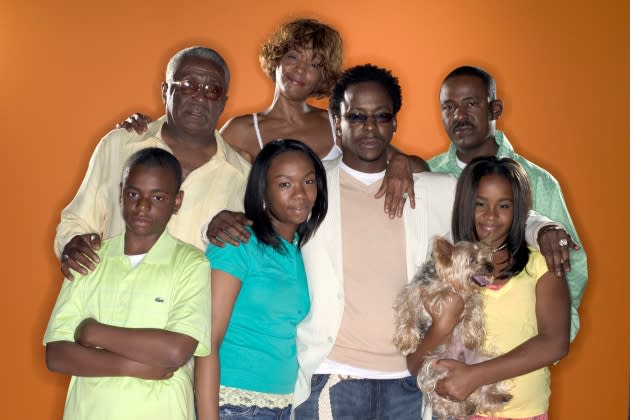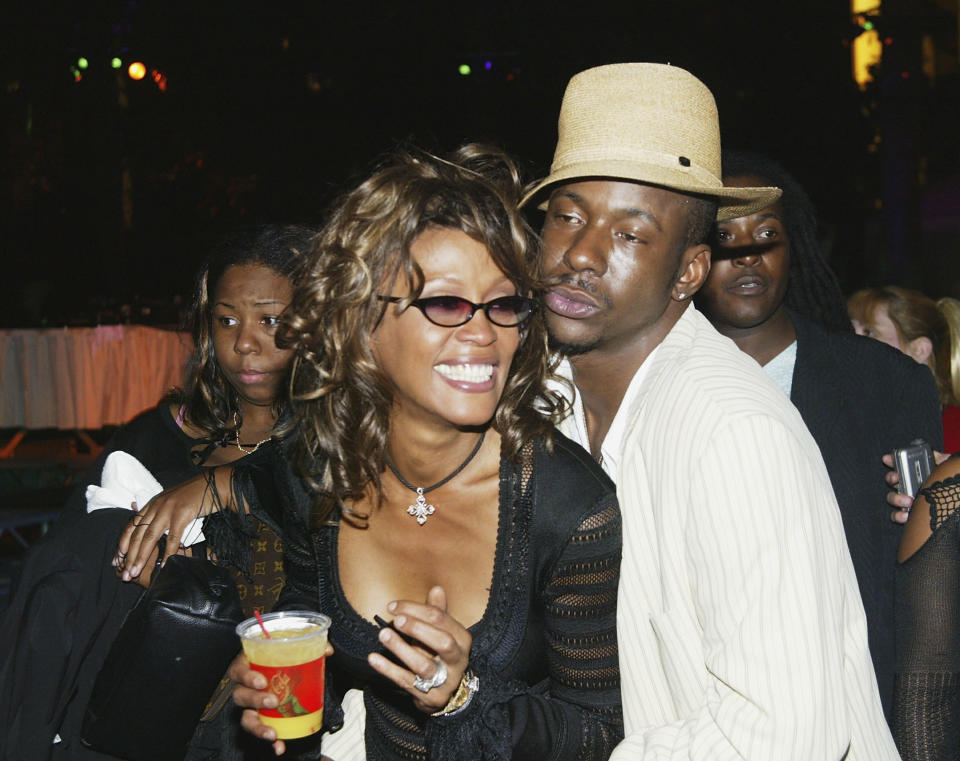The Cruel Reality-TV Exploitation of Whitney Houston
- Oops!Something went wrong.Please try again later.
- Oops!Something went wrong.Please try again later.
- Oops!Something went wrong.Please try again later.
- Oops!Something went wrong.Please try again later.
- Oops!Something went wrong.Please try again later.

In the new Whitney Houson biopic I Wanna Dance with Somebody, Houston’s mother has police escort her daughter from her home (in front of her young daughter, Bobbi Kristina) after finding Houston in a drug-fueled stupor following her father’s death. We next see Houston in tranquil recovery at a rehab center, and later, a recreation of her emotional comeback performance on The Oprah Winfrey Show in 2009. The film excises most of the 2000s from Houston’s story, including her starring role in 2005’s disturbing reality series Being Bobby Brown.
The eleven-episode saga followed Brown, Houston, their daughter Bobbi Kristina, her half-siblings La’Princia and Bobby Jr., Brown’s brother Tommy and his father Herbert. But the married couple were the main draw of a show that chronicled Houston’s temper, Bobby’s brashness, and an overall sense that the pair — Houston especially — were unwell. “Behind the scenes, Houston had been using again,” Vanity Fair reported.
More from Rolling Stone
'I Wanna Dance with Somebody': Fact-Checking the Whitney Houston Biopic
Kasi Lemmons' Battle to Make the Whitney Houston Biopic 'I Wanna Dance with Somebody'
'I Wanna Dance with Somebody' Comes to Praise Whitney Houston, Not to Bury Her
Yet, the show was mostly received with mockery and contempt rather than care and concern. An early hit for Bravo, now famous for its Real Housewives franchise, Being Bobby Brown was reportedly the network’s highest-rated show at the time. Its callousness is what makes I Wanna Dance with Somebody feel necessary – it’s a loving embrace of Houston after years of media exploitation fueled by condescension and sensationalism.
The series allowed its producers and titular star to capitalize on Houston’s distress and the dysfunction of her marriage. Before the show’s premiere, Brown admitted that it was all in service of his image. “On a daily basis, I’m trying to prove my point, that I’m more good than I am bad,” he told The New York Times.
In doing so, he thought the world would see how challenging Houston could be. “Bob’s big thing was everyone blamed him for her downfall, but when he met her she was already using drugs,” Karrine Steffans told Vanity Fair.
Steffans is an author and former music video model who was Brown’s lover in the 2000s during his marriage to Whitney. “He always felt very angry about that. He told me, ‘What everybody saw wasn’t the real Whitney.’ He always said her private persona — which you saw on Being Bobby Brown — was who she really was.” But rather than valorize Brown, the show demeaned both of them. “Not only does it reveal Brown to be even more vulgar than the tabloids suggest, but it manages at the same time to rob Houston of any last shreds of dignity,” wrote one critic in The Hollywood Reporter.
One of the show’s executive producers, Tracey Baker-Simmons, claimed she wanted to tell the story of Brown and Houston beyond the headlines. “Outside of all the negative blurbs, we wanted to know what else is there to these people,” she said.
Brown allowed 24/7 access to himself and his family, but the result fed the prevailing narrative rather than challenged it. Marc Hoeferlin, editor of the documentary Whitney: Can I Be Me, which employed outtakes from Being Bobby Brown, hinted that it didn’t have to be that way. “That show itself comes across as that train wreck of a show,” he told Jezebel. “It wasn’t shot like that. It was shot really well and observationally and I don’t know if that was the intention to do that kind of reality TV thing.”
For Bravo, though, the humbling-bordering-on-humiliation of the once-adored stars seemed to be the point. Lauren Zalaznick, Bravo’s president at the time, reportedly greenlit the series in 15 minutes. “It was very apparent to me that this was something right for Bravo,” she said. “This is very tactile. You feel something when you watch this show.” Zalaznick had been on a mission to bolster “middlebrow” television, claiming that the “channel really became the fullest expression of high-low culture.” She described a show like Top Chef as aspirational, while Real Housewives — where, among other things, rich women bicker and betray each other — could be watched by audiences with a sense of moral superiority. Being Bobby Brown easily fit into that box as well.
In 2009, Houston told Oprah she agreed to be on the show to assuage Brown’s jealousy of her power and profile, and rebuke the world’s disdain for their marriage. So, she played down her success and played up her wifehood.
“I was trying to make a statement, like, ‘You guys aren’t gonna win,’” Houston said. “‘You’re not going to do that. We got married. We were in love. We were crazy for each other. We wanted to have a family. I’m just not going to let you do that to us. I’m just not.’” However, she admitted the fight was futile: “Somehow it got really kind of messy and got lost up in there. And then we started doing other things that entered into the marriage that you just can’t come out straight when you’ve got a lot of outside stuff going on.”
Seven years after Being Bobby Brown aired, Brown admitted that watching it revealed the way drugs had impacted them as a couple. “We was able to see that our drug use had affected our relationship, had affected the love that we felt for each other,” he said.
Rather than parading Houston’s behavioral and addiction issues, I Wanna Dance with Somebody situates her drug use in her pain. We first see her smoke a bong with her brothers to escape a vicious fight between her parents. Later, we see her pull out paraphernalia after jetting home to her husband only to find that he’s not there — and, assumedly, with another woman. In this way, the movie’s portrayal of Houston is gentle — she can still be bold or harsh, but the film holds her with empathy and tenderness.
Some critics of the film have condemned it as too precious with Houston’s drug abuse. “I sense this sort of need to respect the story, but then at the end of the day, [the biopic] felt to me a little bit like an overcorrection… in that, like, it just didn’t really delve too deeply into that,” said NPR’s Aisha Harris. The media’s careless treatment of Houston, epitomized by Being Bobby Brown, is precisely why it didn’t.

The show only lasted one season. Houston refused to appear in a second, so it didn’t get picked up again, though Brown reportedly hoped it would. A year after the show concluded, Houston served Brown with divorce papers. The 2004 filming period became a turning point. During the taping of Being Bobby Brown, Brown was jailed for about a month after multiple probation violations stemming from a 1996 DUI charge. One of the violations was allegedly striking Houston in the face so hard her cheek bruised and inner-lip was cut.
While Brown was behind bars, his sister Tina lived with Houston as she was in the throes of her drug use, and sold scary stories of her addiction to the National Enquirer, which they published in March 2006 (along with the photo Pusha T and Kanye West eventually — and insensitively — used as the album cover for 2018’s Daytona). By 2007, Houston’s divorce from Brown was finalized.
In more recent years, Brown has expressed regret for the show — specifically, for pulling his daughter Bobbi Kristina, who died in 2015 under similar circumstances as her mother, into it. Reflecting on Houston’s infamous Diane Sawyer interview where she declared that “crack is whack,” he also admitted, “There was no reason for [Houston] to be on television, at that time.”
Best of Rolling Stone

